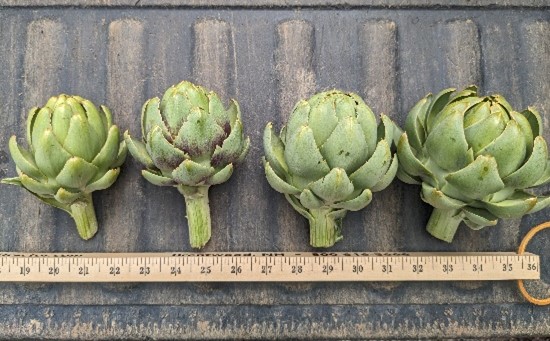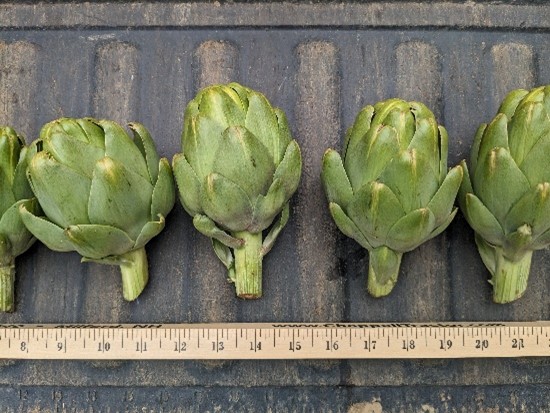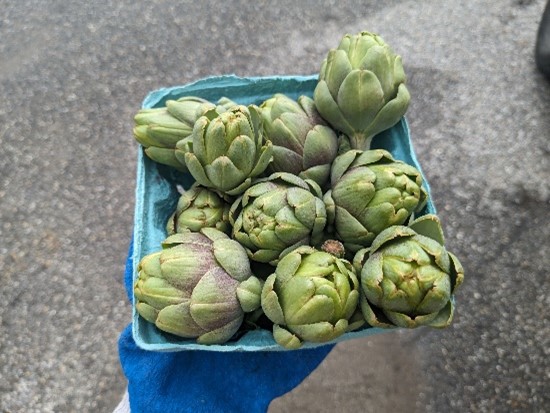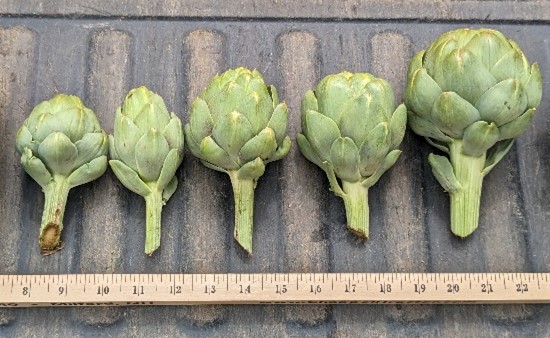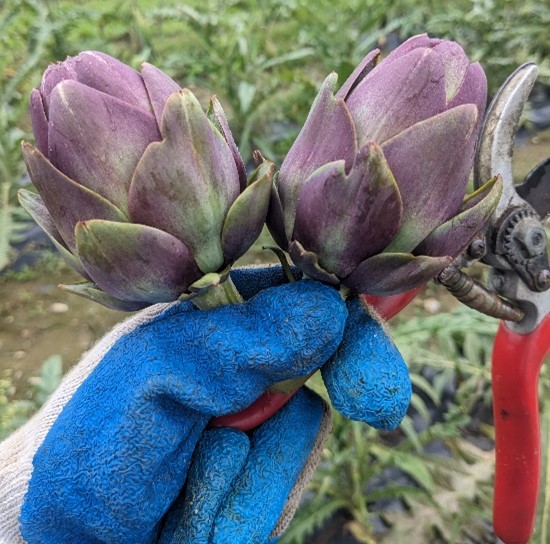2023 Research Report: Artichokes for the Northeast
Peyton Ginakes, University of Maine Cooperative Extension Research Associate
Mark Hutton, University of Maine Cooperative Extension Vegetable Specialist
David Handley, University of Maine Cooperative Extension Small Fruit and Vegetable Specialist
The third year of artichoke trials was conducted at the University of Maine’s Highmoor Farm in Monmouth, ME during the 2023 growing season. The purpose of these evaluations was to obtain additional data towards development of production guidelines and artichoke cultivar recommendations for Maine farmers. Production potential for seven artichoke cultivars was compared. In a separate, concurrent experiment the effects of black mulch, reflective mulch, and bare ground culture on artichoke production were evaluated.
Seedling Production and Vernalization
Artichokes were seeded on March 24 into 50-cell trays filled with Pro-Mix BX with Mycorrhizae media at one seed per cell. Trays were placed on 75 ˚F heating mats 3.5 weeks (Fig. 1). Seedlings were fertilized with 1 Tbsp/gal of Jacks Professional 9-45-15 Plant Starter soluble fertilizer on April 18 and May 12 (25 and 49 days after seeding, respectively).
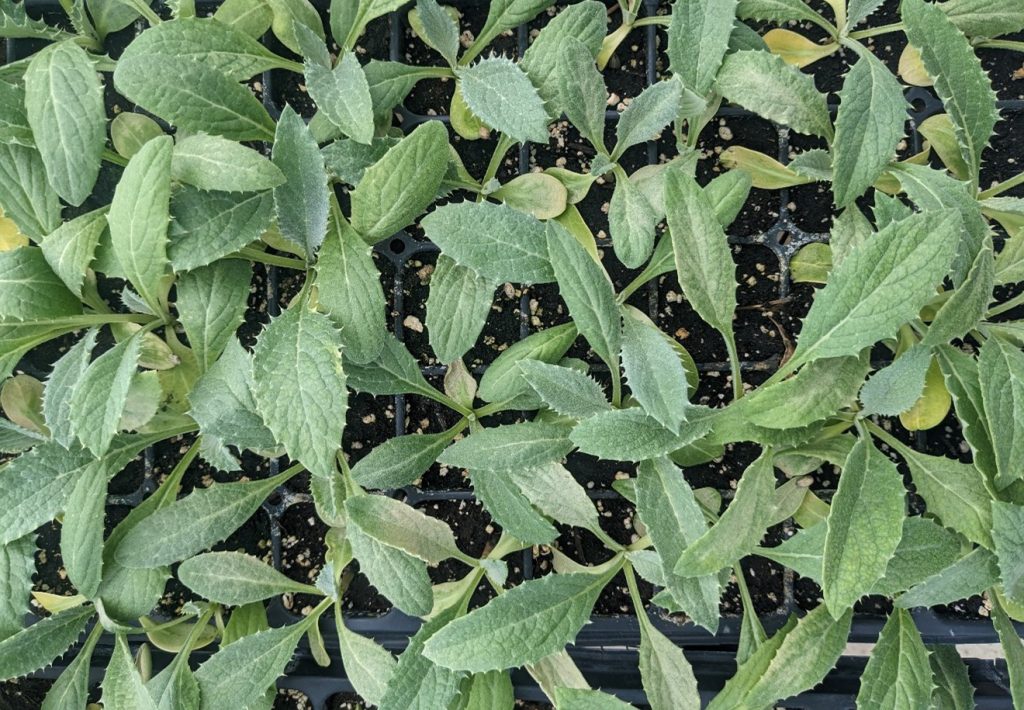
To vernalize plants, trays were moved to a 42 ˚F walk-in cooler for approximately 23 days (550 hours) beginning on May 17. A full-spectrum LED lighting system was placed above the trays and plants were watered as needed (Fig. 2). On June 9, trays were moved outdoors to harden off. This was about a week later than planned because heavy spring rains prevented beds from being formed and mulched. Three days later, seedlings were transplanted by hand using a jab planter (June 12, 80 days after seeding).

Field Preparation
Beds were amended with 500 lb/ac of 10-10-10 fertilizer and tilled to incorporate on May 31, 12 days before transplanting. On June 9, three days before transplanting, raised beds were shaped and covered with 1.1 mil embossed black plastic with drip tape buried right of center under each bed. In the mulch trial, black plastic was removed from bare ground and reflective mulch plots, and re-covered with reflective mulch where appropriate.
Weather
The second wettest growing season on record in central Maine was recorded in 2023 with over 28” of rain. Nighttime temperatures were also unusually warm from May to September – the average low temperature was 52.5 ˚F, the warmest on record for this area. These conditions were challenging for many crops but did not appear to inhibit artichoke vigor or production. Later in the season, however, conditions were very conducive to gray mold (Botrytis cinerea), which led to much greater crops loss than in previous years.
Mulch Trial
We compared production of Green Globe Improved artichoke grown on bare ground, black plastic much, and reflective mulch (Fig. 3). We hypothesized that 1) black plastic would reduce plant vigor by heating the soil and 2) potentially devernalize plants, reducing yield, and that 3) reflective mulch would reduce aphid populations, improving plant health and yield.
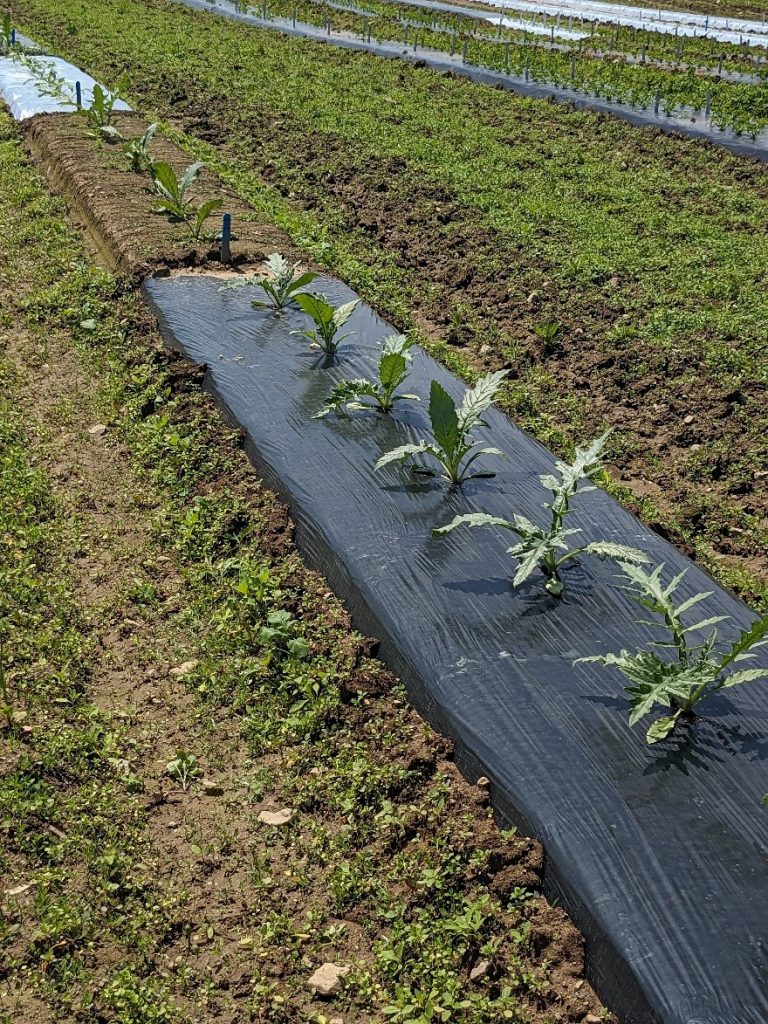
Mulch treatments were arranged in a randomized complete block design and replicated four times. Each plot contained seven Green Globe Improved artichoke plants spaced 2 feet apart within rows, and data were collected from the central five plants individually. After transplanting, plants were immediately watered in with 1 cup of 9-45-15 water-soluble fertilizer solution. Due to the extremely wet season, plants were not irrigated or fertilized for the remainder of the season. Weeds were controlled with hand cultivation and flaming. Captan and Asana® XL (esfenvalerate) were applied at label rates once during the season (July 11, 29 days after transplanting) to control gray mold and insect pests, respectively. Additional pesticide applications may have benefitted artichoke production, but it was too wet to spray.
Harvest began 63 days after transplanting on August 14, earlier and after fewer days post-transplanting than in previous years. Buds were harvested weekly until October 2 (112 days after transplanting), when cull rates became excessive due to gray mold, stink bug (Fig. 4), and aphid pressure. Marketable buds were collected from the central five data plants by clipping with hand shears so that 2-3” of stem remained, and were sorted into USDA size classes of 48s (3-3.5”), 36s (3.5-4”), 24s (4-4.5”) and 18s (>4.5”). Buds smaller than 3” in diameter were deemed marketable despite the lack of a USDA size class because we believe there is market potential for this size in Maine, and were categorized as “very small”. This size class could be sold from bulk containers by weight or pre-grouped into pint or quart cartons, with the intent of marketing them for use similar to the “hearts” of larger sized buds. Here, USDA size classes were grouped into a “large” category spanning 3 – 4.5” in diameter, indicating that any bud at this size had potential for selling individually as per standard practice. Bud numbers and weights were recorded for individual plants.
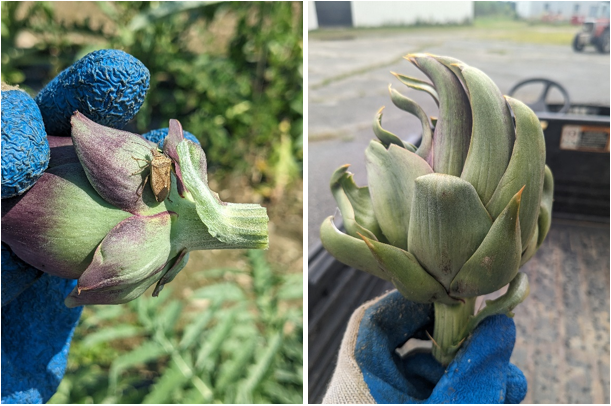
Mulch Evaluation
Nearly all plants produced artichokes regardless of mulch treatment (Table 1), in stark contrast to the poor flowering rate in 2022 mulch evaluations. Improved vernalization conditions probably accounted for this difference. Plants in 2023 received 550 hours of chilling and had supplemental lighting, compared to 303 hours without light in 2022.
| Mulch | Flowering Plants | Marketable Buds per Flowering Plant | % Unmarketable | ||||||
|---|---|---|---|---|---|---|---|---|---|
| Very Small (< 3″) | Large (3 to > 4.5″) | Total Marketable | |||||||
| % | # | g | # | g | # | g | # | g | |
| Bare ground | 95 | 9.2 | 370 | 0.5 | 71 | 9.7 | 441 | 29.7 | 19.1 |
| Black plastic | 100 | 12.2 | 559 | 0.8 | 131 | 13.0 | 690 | 24.8 | 13.7 |
| Reflective | 95 | 16.6 | 679 | 0.4 | 60 | 17.0 | 738 | 31.7 | 22.3 |
* Values in a column with no shared letters indicate a difference between mulches at p < 0.05.
Plants also yielded well across all mulch treatments (Table 1). The number of very small buds generally accounts for most of the increased yield across mulches and varieties. When only large buds are considered, black mulch tended to have higher yields and a higher number of flowering plants, but this effect was not significant overall. The lower yields observed in the bare ground plots may have been due to greater nutrient leaching compared to plastic mulched plots. Interestingly, the aphid pressure did not appear to be reduced by the reflective mulch (Fig. 5).
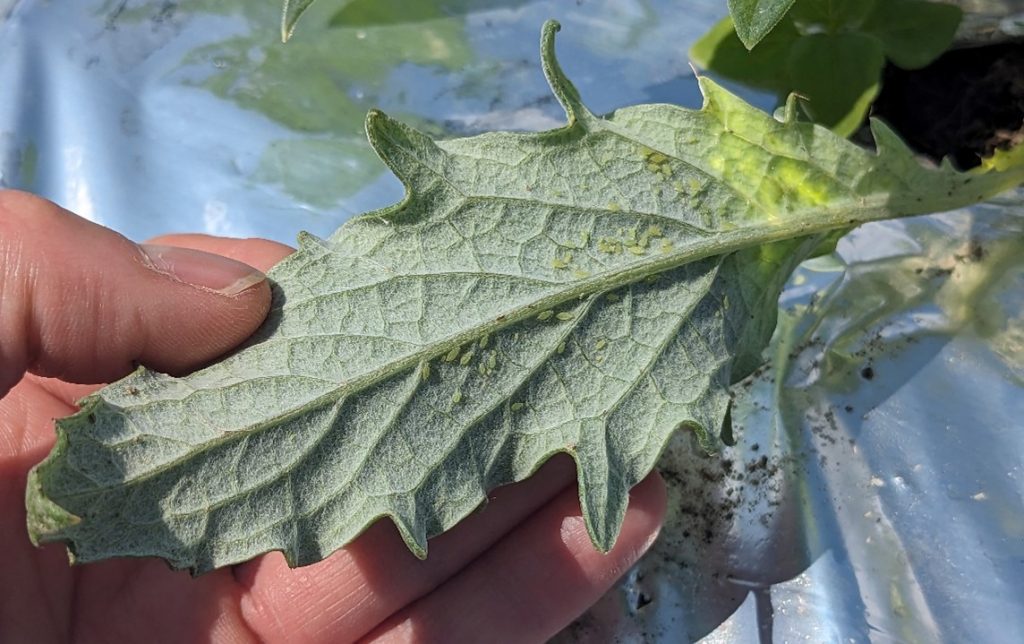
Cultivar Evaluation
| Cultivar | Color | Bred for Annual Production? | Organic Seed Available? | Hybrid Status | Spiny? |
|---|---|---|---|---|---|
| Green Globe Improved | green | no | no | OP | yes |
| Imperial Star | green | yes | yes | OP | yes |
| Imperial Star Purple | purple | yes | yes | OP | no |
| Romanesco | pink | no | no | OP | few |
| Tavor | green | no | yes | OP | few |
| Violetto | purple | no | no | OP | very |
| Wonder | green | yes | yes | OP | no |
Harvest followed the same schedule as the mulch trial. Only 68% of Violetto plants flowered, which was significantly lower than other cultivars (Table 3). Violetto may have a chilling requirement greater than 550 hours, or be particularly prone to devernalization. Tavor and Wonder had the greatest yield of marketable buds. Imperial Star and Tavor produced a significantly greater number of large sized buds compared to Romanesco with close to one per flowering plant. Green Globe Improved, Romanesco, Tavor, and Wonder all produced more marketable buds than Violetto, reflecting the same pattern for the number of very small buds. Very small buds account for the majority of artichokes produced, and factor heavily into total yield differences. Unmarketable buds were primarily due to gray mold and stink bug damage. Production potential, or total yield, was 13 to 45% greater than actual marketable yields because we could not manage these in the wet season.
| Cultivar | Flowering Plants | Marketable Buds per Flowering Plant | % Unmarketable | |||||||||||||||
|---|---|---|---|---|---|---|---|---|---|---|---|---|---|---|---|---|---|---|
| Very Small (< 3″) | Large (3 to > 4.5″) | Total Marketable | ||||||||||||||||
| % | # | g | # | g | # | g | # | g | ||||||||||
| Tavor | 100 | a* | 13.0 | a | 548 | a | 0.9 | a | 153 | a | 13.9 | a | 702 | a | 22.2 | c | 15 | bc |
| Green Globe Improved | 100 | a | 12.5 | a | 526 | ab | 0.4 | ab | 69 | ab | 12.9 | a | 595 | ab | 22.1 | c | 15 | bc |
| Wonder | 97 | a | 12.0 | a | 555 | a | 0.7 | ab | 129 | ab | 12.7 | a | 683 | a | 23.1 | bc | 14 | bc |
| Romanesco | 88 | a | 12.2 | a | 510 | ab | 0.3 | b | 42 | b | 12.5 | a | 552 | ab | 15.2 | c | 11 | c |
| Imperial Star | 100 | a | 9.5 | ab | 430 | ab | 0.8 | a | 136 | ab | 10.3 | ab | 566 | ab | 44.7 | a | 30 | a |
| Imperial Star Purple | 92 | a | 9.0 | ab | 372 | ab | 0.4 | ab | 68 | ab | 9.5 | ab | 440 | b | 37.8 | ab | 26 | ab |
| Violetto | 68 | b | 6.1 | b | 346 | b | 0.6 | ab | 91 | ab | 6.7 | b | 437 | b | 13.0 | c | 11 | c |
* Values in a column with no shared letters indicate a difference between mulches at p < 0.05.
Green Globe Improved
- Older standard cultivar
- Generally high-yielding
- Underwhelming consistency and appearance
- Bracts tend to be pointed and often splay prematurely
- Spiny
Imperial Star
- First cultivar bred for annual production
- Generally a top-yielding variety, although may be especially susceptible to gray mold
- Nicer buds have commercial quality, but inconsistent
- More attractive than Green Globe Improved with less pointed bracts and tighter, slightly more elongated buds
- Very spiny
Imperial Star Purple
- Bred for annual production with Imperial Star parent
- Lower yielding than Imperial Star
- Purple at base of bracts is very subtle and can be totally absent in warmer temperatures
- Otherwise very similar in appearance to Imperial Star
- Spineless
Romanesco
- Heirloom variety with occasional rosy blush color at bract tips
- Markedly less vigorous than other cultivars
- Lower yield of large buds
- Variable bud and bract shapes
- Highest quality are the very small buds
- Few spines
Tavor
- High-quality and high-yielding
- More uniform appearance than Green Globe Improved and Imperial Star
- Buds are generally dense, compact, and round
- Rounded bracts sit around receptacle (heart) rather than on top of it, giving it a nice shape
- Commercial quality
- Few spines
- Organic seed available
Violetto
- Extremely variable cultivar
- Gorgeous purple color in cool end-season temperatures
- Elongated buds and bracts with shapes that vary from oval to vase-like to fountain-shaped
- Strong tendency to splay at larger sizes
- Smaller buds can be nicely compact
- Low flowering rates and yields
- Spines can be 2-3 mm long
Wonder
- Hybrid spineless variety bred for annual production
- Variable yields
- Relatively compact buds, but shape is more variable than expected for hybrid
- Some commercial quality buds
- Spineless
- Organic seed available
Acknowledgements
This work was supported by the University of Maine Agricultural and Forestry Experiment station, the Maine Vegetable and Small Fruit Growers Association, and Hatch ME022320. High Mowing Seeds generously donated materials for this project. We are grateful for assistance from Greg Koller, Patricia McManus, and Stephanie Wright, and field assistants Chantal Cyr, June Foyt, and Ethan Handley.
Please contact Peyton Ginakes at peyton.ginakes@maine.edu, or Mark Hutton at mark.hutton@maine.edu, or call (207)933-2100 with any questions or comments about this research.
Download and Print:
Information on this website is provided purely for educational purposes. No responsibility is assumed for any problems associated with the use of products or services mentioned in this website. No endorsement of products or companies is intended, nor is criticism of unnamed products or companies implied.
In complying with the letter and spirit of applicable laws and pursuing its own goals of diversity, the University of Maine System does not discriminate on the grounds of race, color, religion, sex, sexual orientation, transgender status, gender, gender identity or expression, ethnicity, national origin, citizenship status, familial status, ancestry, age, disability physical or mental, genetic information, or veterans or military status in employment, education, and all other programs and activities. The University provides reasonable accommodations to qualified individuals with disabilities upon request. The following person has been designated to handle inquiries regarding non-discrimination policies: Director of Equal Opportunity, 101 Boudreau Hall, University of Maine, Orono, ME 04469-5754, 207.581.1226, TTY 711 (Maine Relay System).

